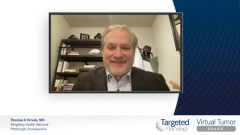
Case 1: First-Line Maintenance Therapy in Advanced Ovarian Cancer
John K. Chan, MD, leads a discussion on the role of first-line maintenance therapy for advanced ovarian cancer and the standard of care first-line maintenance approaches for a patient with gBRCA2-mutated disease.
Episodes in this series

Thomas C. Krivak, MD: This patient tested for BRCA2 and was noted to be a germline-positive test. With respect to her work-up at this point, we know that she has a BRCA2 mutation, she underwent genetic testing. This patient presented with bilateral adnexal masses, an elevated CA 125 [cancer antigen 125], pelvic and inguinal lymph node lymphadenopathy. She underwent an exploratory laparotomy, tumor debulk which included removal of the pelvic and paraaortic lymph nodes, tumor debulking of the inguinal lymph nodes, appendectomy, and she was optimally debulked to microscopic disease. Once she healed from this, she went ahead and was treated with carboplatin and paclitaxel [Abraxane], as well as antiemetics to help with the chemotherapy-induced nausea and vomiting. She experienced some grade 2 nausea as well as vomiting throughout her chemotherapy, and she was anxious before, during, and after chemotherapy infusions.
After her last dose of chemotherapy, her CA 125 is normalized. She had a CT scan. She was in complete response in remission. By physical examination, CA 125, as well as CT scan. She is scheduled to start maintenance therapy. Her current weight is now 140 pounds.
To summarize, this patient was optimally debulked to microscopic disease, has advanced-stage ovarian cancer, and a BRCA2 mutation. We discussed the testing guidelines, and we have a positive test here that we know is actionable. But there’s some questions that we want to talk about with respect to the treatment of this patient, and again to think about what every patient with newly diagnosed advanced-stage ovarian cancer receives first-line maintenance therapy. Another question we need to address is which first-line maintenance therapies are the standard of care, like having a BRCA2 germline mutation advanced ovarian cancer, and again what are some of the efficacy and safety data to guide our treatment recommendations for upfront maintenance therapy and then what criteria do you use to determine a maintenance therapy for use in a patient like this? To me, John, why don’t you go ahead and talk about how you think about every patient, advanced-stage ovarian cancer? What’s your thought with getting first-line maintenance therapy?
John K. Chan, MD: That’s a good question. When I see a patient in my office with upfront ovarian cancer or ovarian cancer diagnosis, I think of 3 questions. The first question that in my mind is should we do surgery on this patient, or should we do neoadjuvant chemotherapy with interval cytoreductive surgery? After I figure that question out, then my second question is do we give bevacizumab [Avastin]? Do we add an anti-vascular agent to decrease their tumor burden, decrease their ascites, their effusions, to help them get better quality of life, and with some progression-free survival benefit? The third question I ask is based on what we decided in terms of their anti-vascular treatment, yes, no, then I look at the tumor markers with respect to their, number 1, germline mutation, somatic mutation, number 2, their HRD [homologous recombination deficiency] status or their HR [homologous recombination] proficiency, and based on those 3, then I determine how to treat these patients.
Let’s just take the first example. Let’s say it’s a patient with a large ascites and we decided to give Avastin [bevacizumab]. In that patient, if they were germline positive or somatic positive, I would treat them with combination with bevacizumab and olaparib [Lynparza]based on the PAOLA study. The patients who are HRD, I do the same thing, or I offer these patients also niraparib [Zejula]. Sometimes I stop Avastin if they don’t get the benefit anymore and I just treat them with a single agent.
When you say that first question, should every patient get first line, I would say in my practice, over these few years, most of my patients will undergo first-line maintenance therapy based on these recommendations. And the patients who didn’t get Avastin, which is the second half of our patients, it’s about 50% of my patients have neoadjuvant chemotherapy, and if they didn’t get neoadjuvant with adjuvant bevacizumab upfront, then for those patients I would just give single agent olaparib based on SOLO-1. If they’re HRD positive, I offer them niraparib, and then if they’re HR proficient, this becomes a real discussion between the doctor and the physician because the benefit associated with HR proficiency associated with these PARP inhibitors is marginal, 3 to 4 months. It’s a discussion with the patient looking at the toxicity of the drug, with the smaller benefit associated with this subgroup, whether or not it’s important to get the PARPs in so that we won’t miss the opportunity in the future because HR proficient patients won’t do as well and their access to these PARP inhibitors may not be there if we give up the upfront opportunity today.
Thomas C. Krivak, MD: That’s excellent. I like how you break it down and are using these molecular characteristics of the tumor to help make some of the decisions, as well as looking at the functionality of the patient, how you describe clinical as well as molecular factors. Cecelia, how about what Dr Chan said and then moving into that second question there, which first-line maintenance therapies are the standard of care for a patient who has a germline BRCA2 mutation, and then discuss monotherapy versus combination therapy. Dr Chan had touched on that. Then, what do you think about the NCCN [National Comprehensive Cancer Network], as well as ASCO [American Society of Clinical Oncology] guidelines?
Cecelia H. Boardman, MD: The luxury for a germline BRCA mutated patient is they have a lot of options. They have the option to do monotherapy with PARP. They have the option, if for some reason they don’t feel comfortable with the concept of PARP, they could do monotherapy with Avastin, or based on the PAOLA data we have the option for combination therapy and maintenance. The key thing is, I agree with John, you look at the clinical indicators, you look at stage, you look at cytoreductive status, you look at presence or absence of ascites or pleural effusions. There’s some really interesting data when you look at PAOLA and you look at patients that you wouldn’t traditionally treat with Avastin. Avastin plus olaparib in the optimal stage 3 patient has some impressive progression-free survival data. It’s caused me to go back and look again at the question of should we use combination in the germline patients because even though they do well, they could potentially do even better with the combination of Avastin plus olaparib.
It’s an evolving standard and I do involve the patient in that decision-making process, because obviously a PARP inhibitor that you take orally, you get lab work frequently, but you’re not necessarily in the office frequently. For that patient who travels a distance, certainly the patient population that you see a lot, Tom, coming from far away or being serviced by medical oncology in the community, the ability to have more flexibility with their treatment schedule compared to that every 3 week infusion with Avastin also weighs heavily in that decision. I engage the patient in the decision-making and I share with them what their choices are and allow them to help guide me in that recommendation of what logistics make sense. But I do encourage patients towards maintenance therapy because for the most part we see benefit across the board, and if we can maintain platinum sensitivity, it serves the patient well.
Thomas C. Krivak, MD: Yes, that’s a really good point. You all have summarized things nice with respect to the combination therapy and the single agent therapy. Obviously, this patient was nervous about coming into the chair, was nervous about infusion, there may be some apprehension about ongoing with bevacizumab or initiating bevacizumab even though I think bevacizumab is a very versatile medication with very good tolerability and low adverse effects.
Transcript Edited for Clarity











































